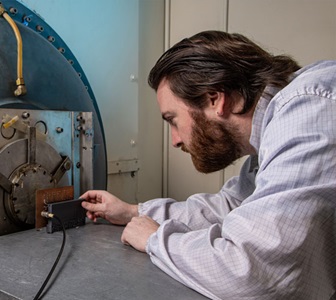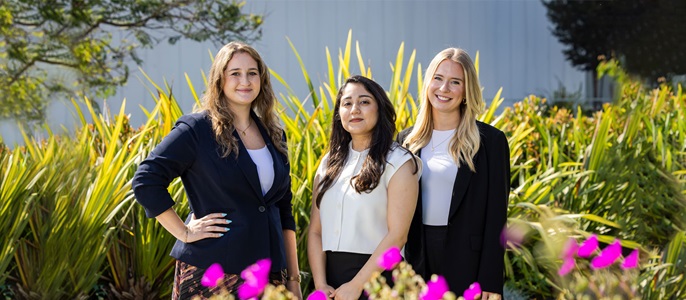Radiation Test Engineer Taylor Fry is the only former astronomy adjunct professor in Northrop Grumman’s Radiation Test Operations Lab.
Igniting the Next Generation
Sparking Curiosity and Launching Future Engineers

By Alessia Grijalva
In 1996, while reading a Parks and Recreations booklet listing local community events and courses in Chandler, Arizona, Propulsion Engineer Brian Katz was inspired to create something engaging — while sharing his love for rocketry.
“I was inspired by the Apollo missions that I saw on TV in the early 1970s and always desired to be a part of rockets in some way,” said Brian of his career inspirations. “If I can somehow share that inspiration with others, I jump at the opportunity to do it.”
Brian created a 10-week course covering different rocketry topics and submitted his proposal to the Chandler Parks and Recreations committee. He soon began teaching the children’s course, originally named the Space and Rockets Class, several times a year. Eventually, a parent asked if Brian could bring the lessons to her child’s school, Jacobson Elementary.
The Space Explorers club was born.
Building a Foundation
For the last two decades, the club has met once per month during the lunch hour at Jacobson with a focus on third through sixth graders. During each 40-minute session, students learn about various elements of rocketry, including rocket vehicle design and basic principles of orbital mechanics. As part of the curriculum, volunteers, including Brian, work with students as they build their own model rockets and prepare them for launch.
“My goal is to try and re-create that same feeling I had when growing up and learning about the Apollo missions,” said Brian. “When the students can physically see the results of what they are learning, you can feel the energy in the room and their eyes light up. I want them to not only leave inspired but with the ability to go home and talk about rockets and all the components that lead to successful launch.”
More than 15 years ago, Tim Barron participated in Space Explorers as a third grader. His interaction with Brian and the Space Explorers volunteers — Northrop Grumman employees and leaders — inspired his curiosity to explore space and eventually pursue a career in engineering.
“As a kid, you would never think you would meet a rocket scientist, let alone have them in the classroom teaching you about their work,” said Tim. “The best part was the lunch and launch at the end of the event, where students and their families would show up for a picnic, and we would all enjoy the nice weather and get to launch the rockets we’d spent the last several weeks building.”
When Inspiration Becomes Real Life
After graduating from Arizona State University, Tim fulfilled his dreams and joined Northrop Grumman, where he now works as a mechanical engineer for the Ground-Based Midcourse Defense (GMD) interceptor program. Working on the FTG-12 mission — which included the successful GMD flight test and Northrop Grumman IRBM target launch and intercept — took him back to his roots.
“The pre- and post- launch dinner celebrations for a real launch aren’t all that different from the one I remember doing for Space Explorers,” said Tim. “It really goes to show how involved the engineers here at Northrop Grumman are with the community. I would have never guessed that I would be working alongside the very same people who helped inspire my love for rockets.”
And while they don’t directly work alongside each other, both Brian and Tim’s work has helped Northrop Grumman develop and launch various vehicles that help launch and test interceptor and target programs. With a career spanning multiple decades across programs like GQM and Zombie, focused on testing interceptor and defense systems, Brian said he takes pride in the lasting impact of his work, both in his day job and in working with young people. He encourages others to share their interests and welcomes new volunteers each year to share their expertise with students.
“To anyone who asks, I say that sharing what you love to do with young minds is just as gratifying as actually doing the work,” said Brian. “You are in one of the most unique technological fields and have such a special knowledge that is a wonder for so many young minds.”
Life at Northrop Grumman
Your work at Northrop Grumman makes a difference. Whether you want to design next-generation aircraft, harness digital technologies or build spacecraft that will return humanity to the moon, you’ll contribute to technology that’s transforming the world. Check out our career opportunities to see how you can help define possible.


